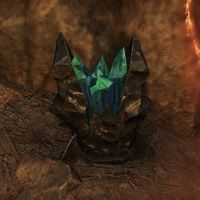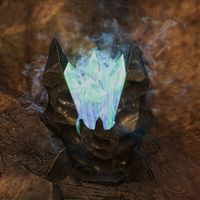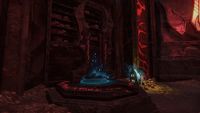| This page or section is incomplete. You can help by adding to it. Needs new information added from Gold Road For more information, see the help files, the style guide, and this article's talk page. |
Lucents are crystals of Daedric origins with the ability to contain and release energy. They are incorrectly likened to Soul Gems by some scholars due to mostly superficial similarities between them.[1] Unlike soul gems, lucents can be reused numerous times, provided they are recharged. When shattered they create destructive explosions. Also unlike soul gems, they are powered by the background energy that pulses through all the realms of Oblivion. Although they can be commonly found in the mortal dwellings within the realms of Oblivion they are rarely used by non-Daedra.[2]
Several theories existed about the nature of the energy stored inside lucents. Some of the mages of House Hexos believed that they hold some sort of "Daedric magicka". The Mages Guild dismissed that theory as absurd, due to their belief that magic comes from Magnus. Lissinia Cattalus, a mage and scholar, tried to split the difference with her "Mundial Emanation" theory. She proposed that "Oblivion magic" is the residue of the et'Ada's act of creation. She likened this phenomenon to a wave of creative energy that burst forth when Magnus and Magna Ge broke the firmament of the mortal realm. Her theory also contained the notion of "the manifest dynamism of Oblivion"—an omnipresent force that gives Oblivion its shape and basic laws. Mages of the House Hexos admitted to a lack of understanding of the origins and true nature of Lucents but focused on utility provided by the material. The act of quantifying of the Lucent energy is unknown to them.[1] Some sources refer to the energy stored within lucents as the "ever-present and permeating energy of Oblivion".[3][4]
It was theorized that the lucents are comparable to skyshards and that they "fell" into Oblivion's various realms.[1] Some sources state that lucents form naturally in the Void and occasionally rain down on the various realms and that they are crystallized bits of Oblivion.[2] In the raw form the crystals contain minuscule amounts of energy and need to be charged.[1]
The process of recharging Lucents involves items known as "dynamus fonts".[1][2] The art of creation of those items was unknown for the mortal scholars. Still, they were available for purchase from Daedric merchants. Slotting a lucent into the hollow of a font recharges the crystal. According to some Daedra and mortals, fonts contain Atronach whose power is siphoned into the lucent, though the validity of such theories is uncertain.[1][2] Other accounts state that dynamus fonts rely on the ambient dynamism that flows through the space between the realms.[2]
Once lucents are charged their power can be utilized for various purposes with the usage of the Daedric devices known as "discharge labrums".[1] Labrums are typically integrated into larger mechanisms. Lucents are typically plugged into them to be discharged. Another way to discharge the lucent is to shatter it. Doing so creates a destructive explosion and destroys the lucent rendering it useless.[2]
Lucents in conjunctions with aforementioned tools are often utilized by the Daedra to open and lock doors,[5][2][1] erect barriers,[1][2] empower displacers,[1][6] and for other purposes,[1] such as maintaining operational portals,[7][8][9], igniting furnaces,[10] and operating Daedric devices.[2] Discharge labrums are integral element of Daedric wards.[2][11] Charged lucents pulse with energy,[3] and glow,[2][12] while discharged ones are dull and lifeless.[4] Daedric mechanisms and barriers can be also overcharged and deactivated through the usage of the lucents.[2][13]
Little is known of the classification and different variations of the lucents, but Indigo Lucents,[14] and powerful Master Lucents[15] are known subcategories of those gemstones.
House Hexos planned to integrate them into their security structure.[1] The Grasp of the Stricture utilizes material known as Indigo Lucent in the process of crafting of their armaments.[14] Inferniums are known to consume master lucents.[15] Knowledge of the lucent usage was limited also within the mortal cults devoted to Mehrunes Dagon such as the Order of the Waking Flame.[11]
The ancient Chimer were known to utilize lucents. The High Velothi ur-mages, who were the most potent sorcerers among the ancient Chimer, were known to wear "a light upon the breast" as a protective measure when interacting with Daedra. Some of their amulets featured lucent components.[16]
GalleryEdit
ReferencesEdit
- ^ a b c d e f g h i j k l Lessons on Lucents — Roganus Atius, Chief Researcher of House Hexos
- ^ a b c d e f g h i j k l The Anchorite's dialogue in ESO: The Deadlands
- ^ a b Charged Lucent's item description in ESO: The Deadlands
- ^ a b Lucent's item description in ESO: The Deadlands
- ^ Events of The Durance Vile in ESO: The Deadlands
- ^ Arox the Mutilator's dialogue in ESO: The Deadlands
- ^ Events of Death Stalks the Weak in ESO: The Deadlands
- ^ Note from Valkynaz Nokvroz — Valkynaz Nokvroz
- ^ Note from Valkynaz Nokvroz's item description in ESO: The Deadlands
- ^ Events of The Last Ambition in ESO: The Deadlands
- ^ a b Waking Flame Journal — Devastator Khashi
- ^ Khazasha's dialogue in ESO: The Deadlands
- ^ Events of The Celestial Palanquin in ESO: The Deadlands
- ^ a b Fargrave Guardian Style's crafting material in ESO: The Deadlands
- ^ a b On Inferniums — Pelagius Habor, Council Daedrologist-in-Residence, Imperial City
- ^ Velothi Ur-Mage's Amulet antiquity codex entry in ESO: Necrom



